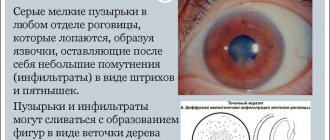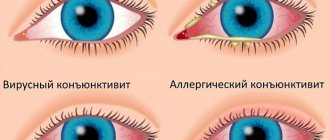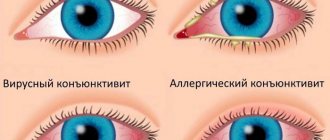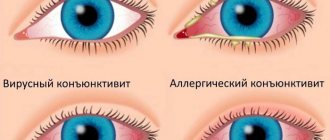A person who has never had problems with the organs of vision can face such a problem as redness of the eyes and increased tearing. Despite the fact that such phenomena are not signs of any serious ophthalmological disease, they indicate that not everything is in order in the body.
And by promptly identifying and eliminating the reasons why your eyes itch and turn red, you can save yourself not only from discomfort, but also from more serious consequences.
Itchy and red eyes: causes
If there is itching and redness of the eyeball, as well as increased tearing, it is important to identify the main factors. Some of the most common causes are allergens with which the patient comes into contact:
- cosmetical tools;
- animal hair;
- linen mites;
- hygiene products;
- flowering plants.
If the patient has conjunctivitis or an infectious disease, symptoms such as swelling of the eyelids, itching in the outer corners of the eyelids may additionally be observed.
Patients often complain that when their eyes are red and itchy, they also notice blurred vision. This may be due to the following factors:
- mechanical injury;
- exposure to caustic chemicals;
- incorrectly selected lenses or glasses;
- lack of sleep, overwork, prolonged work at the computer at night.
Having identified the causes of the disease, they can be easily eliminated, for example, stop using allergenic cosmetics, change down bedding to synthetic ones, and reduce the time you use the computer and mobile devices. However, there are more serious reasons and those associated with systemic diseases in the body. Such reasons include:
- increased blood pressure, which can lead to hyperemia of the eyeball, as well as rupture of thin eye vessels;
- the presence of infectious diseases that can affect the organs of vision, for example, affect the mucous membrane of the eye;
- increased intracranial pressure, which may be accompanied by severe headaches, dizziness, loss of consciousness and other symptoms.
Depending on the reason why the eyes itch and turn red, as well as the source of the lesion, measures are taken, including the use of medications, which will eliminate these causes and completely restore the functions of the visual organs.
Preventing yellowing of the eyes
To preserve the natural color of the proteins, you must:
- Eat right. In order for the body to function normally, it must be nourished with all the essential nutrients. Changes should be made to the daily diet: do not eat over-salted, spicy, fried and smoked foods, give up confectionery, do not abuse alcoholic beverages, add as many fresh vegetables, fruits and berries to the menu as possible.
- Don't forget about physical activity. Long walks, running, and cycling are recommended.
- Enough sleep. A full night's sleep for an adult should last at least 7 hours.
- Maintain a work and rest schedule. Work done in front of the monitor must be alternated with rest.
- Take vitamin complexes. They contain all the components essential for the body in sufficient concentration. Such complexes have a beneficial effect on the functions of all organs, including the liver.
To prevent the whites of your eyes from turning yellow, you should carefully monitor your health. It is recommended to eat high-quality and healthy food filled with vitamins and microelements. To prevent yellow eyeballs from appearing, you should watch less TV and sit at the computer
It is important to monitor liver function, especially if you are predisposed to diseases of the internal organ. Routine examinations by doctors help prevent deviations in the early stages of development. https://www.youtube.com/embed/5j12JstN7Y4
Disease is always easier to prevent than to treat
Therefore, it is extremely important to adhere to preventive measures, which include a number of measures:
Nutrition is of great importance. To return the sclera to its natural shade, eat vegetables and fruits, fermented milk products and lean meats; Normal functioning of the body is ensured by physical activity. To the best of your ability and strength, exercise regularly
Or walk outside every day for sixty minutes; It is important to sleep at least eight hours. During the night's rest, the liver is restored, and subsequently it is easier for it to cope with heavy loads; Alternate periods of work and rest. If you have to sit at the computer for a long time, take a break every forty minutes; Take a vitamin-mineral complex
It will help replenish the lack of nutrients in the body and improve the functioning of the liver.
If you have to sit at the computer for a long time, take a break every forty minutes; Take a vitamin-mineral complex. It will replenish the lack of nutrients in the body and improve the functioning of the liver.
Children's eyes become itchy and red
Itching and redness of a child's eyes is an alarming symptom. Of course, such phenomena can occur due to the fact that the child swam in the pool for too long, was overtired, did not sleep enough, or simply rubbed his eyes with his hand due to dust getting into them. But they may also indicate the occurrence of an ophthalmological disease. There are several reasons why a child’s eyes itch and turn red:
- infection with viral infections. In addition to redness of the eyes and increased tearing, the disease is accompanied by cough, runny nose, fever, and chills.
- infection with bacterial infections. Such diseases can be focal in nature, accompanied by accumulations of pus in the corners of the eyes and other phenomena.
- allergy. With this disease, in addition to itching and redness of the eyes, a runny or stuffy nose, sneezing and other symptoms appear.
- injury to the cornea or foreign bodies entering the eye.
In any case, if a child’s burning sensation, itching, redness of the eyes, increased tearing or, conversely, dry eyes, pain persists, this is a reason to visit an ophthalmologist to make a diagnosis and prescribe effective therapy.
What diseases can be identified with this symptom?
Timely diagnosis of red eyes is very important for recognizing serious diseases. Determining the diagnosis in the early stages of the disease significantly facilitates its treatment and prevents complications.
Determining the diagnosis in the early stages of the disease greatly facilitates its treatment and prevents the occurrence of complications.
Redness of the protein can be a manifestation of the following diseases:
- Conjunctivitis;
- Keratitis;
- Blepharitis;
- Iridocyclitis;
- Episcleritis;
- An attack of glaucoma.
Keratitis
It manifests itself in almost the same way as conjunctivitis, but differs from it in that the inflammation is concentrated in the cornea.
In addition to redness, the patient feels soreness and experiences photophobia. The outcome of the disease can be severe complications, including loss of vision.
Blepharitis
It occurs due to inflammation of neighboring areas: areas of the mouth or nose, tonsils.
Inflammatory processes on the skin also contribute to its development. Mostly it has a chronic form.
It is worth noting! Consolidation and redness of the eyelid is the first sign. The cause of the disease is a change in microflora.
There are a number of factors influencing its change:
- Chronic infections;
- Fungus;
- Worm infestations;
- Gastrointestinal tract disorders;
- Allergy;
- Decline of immunity;
- Diabetes.
Iridocyclitis
Caused by inflammation of the iris for a number of reasons
These include: past or ongoing infectious diseases (measles, tuberculosis, gonorrhea, malaria and the like); metabolic disease.
In advanced cases, changes in the pupil and even the color of the iris are observed.
Episcleritis
The outer layer of the sclera of the eye is called the episclera. The episclera itself is also covered with a membrane - the conjunctiva.
They are directly related to each other, and therefore infection of the conjunctiva often leads to inflammation of the episclera.
Carefully! Also, infection in the episclera can be transferred from the iris of the eye. The presence of the disease is usually closely related to the course of other infectious diseases
Glaucoma attack
This is a dangerous condition caused by a deterioration in the circulation of ocular fluid, leading to an increase in intraocular pressure.
Redness and severe pain in the eyes are hallmarks of glaucoma. They are accompanied by nausea, headache and blood pressure.
Due to the presence of symptoms similar to those of other non-eye diseases, an attack of glaucoma is poorly diagnosed.
When you suspect an attack of glaucoma, you need to act quickly and decisively. You should seek medical help immediately.
If you are at home and waiting for the ambulance to arrive, you need to make yourself a hot foot bath. Most likely, this will help reduce the severity of the attack.
What to do if your eyes are red and itchy
If the symptoms are prolonged and the discomfort intensifies, then it is necessary to consult a doctor who can determine the causes of these phenomena and prescribe treatment to restore the functions of the visual organs.
The diagnosis is made after a thorough examination, in some cases a detailed one. Quite often, biomicroscopy and special illumination created by a slit lamp are used for diagnosis. Depending on the symptoms, smear analysis and cytological examination may be required. Once a diagnosis is made, therapy is prescribed. Most often, the ophthalmologist prescribes the following medications - eye drops or ointments. Eye rinsing with decoctions of medicinal herbs and compresses may be prescribed. If a child is undergoing treatment, it is recommended to refrain from visiting kindergarten or school to prevent infection of healthy children.
Symptoms of a serious illness
Is your upper eyelid itchy and swollen, causing itching, redness and watery eyes? Perhaps these are signs of a serious disease that develops gradually and is hidden. Similar symptoms may occur when:
- Disorders of metabolic processes in the body.
- Diabetes mellitus.
- Disorders of the digestive system.
- Worm infestation.
- Liver diseases.
- Alcohol abuse and smoking.
- Due to incorrectly selected lenses or glasses.
How to treat if your eyes are red and itchy?
Drug treatment is prescribed not only depending on the type of disease, but also on the degree of dysfunction of the visual organs. Most often, therapy is carried out, including two main types of treatment:
- Etiological: drugs are prescribed that act on the factors that cause inflammatory processes, in which the eyes turn red, itching, irritation, pain and other phenomena appear.
- Symptomatic treatment: this therapy is aimed at eliminating the symptoms of diseases.
If before treatment the patient used vision correction devices such as eye lenses, then it would be better to stop wearing them for a while and use glasses during this period.
Depending on the causes of the disease, in which the eyes are red and itchy, the following treatment methods are used:
- Drops of vasoconstrictor action, which quickly relieve redness of the eyeball;
- Moisturizing drops if there is increased sensitivity of the eyes and dryness of the mucous membrane;
- Antihistamines to eliminate allergic reactions;
- Antiviral, antibacterial, anti-inflammatory drugs;
- Vitamin complexes that are prescribed to enhance the therapeutic effect of basic medications.
Pathogenic causes
This group includes pathologies caused by weak immunity, allergies, bacterial or viral infections, and parasites.
Allergic reaction
The body's reaction to allergens that irritate the mucous membrane. It most often occurs in the spring, when plants begin to bloom and a huge amount of allergens enter the air. Because of them, the eyes begin to dry out and itch from the inside. Certain foods can cause a reaction: milk, eggs, chocolate, citrus fruits, pomegranates or strawberries.
Taking certain medications can also lead to allergy symptoms. These include antibiotics, vitamin complexes and preparations containing iodine. In women, allergies can be caused by incorrectly selected cosmetics.
Diagnosis of allergies is carried out using a series of laboratory tests that can pinpoint the cause of the discomfort. After this, the doctor selects antihistamines.
To prevent itching, you can wash your eyes with special drops several times a day. This reduces contact of the mucous membrane with allergens.
Conjunctivitis
Inflammation of the mucous membrane, which is based on an allergy or infection. The infectious form is usually caused by viruses or bacteria, very rarely by a fungus. The disease can be transmitted from person to person through contact.
With conjunctivitis, itching is the first sign that requires you to consult a doctor to select treatment. During therapy, local antiviral or antibacterial drugs are used in the form of eye drops or ointments.
Blepharitis
Inflammation of the eyelids caused by anemia, diseases of the digestive system, diabetes, infection and other pathologies. As blepharitis develops, the refractive function of the eyes deteriorates, causing concomitant pathologies, such as farsightedness, to appear. The patient has a desire to scratch his eyelids, swelling forms.
The disease is accompanied by the formation of small scales or ulcers along the edges of the eyelids. Treatment of blepharitis takes a long time and, in addition to getting rid of the symptoms, includes eliminating the causes of its development.
Demodicosis
Damage to the skin by the parasitic demodex mite. The activity of the parasite leads to itching from the inside, pain and itching of the eye. The main method of treatment involves the use of gels or ointments that reduce the activity of the parasite.
Dry eye syndrome
Causes dryness and swelling of the mucous membrane, itching. The patient feels as if sand has gotten under his eyelids, which is why he begins to rub his eyes frequently, aggravating the condition. The syndrome is caused by a lack of tear production.
Dry eye syndrome is usually experienced by older people; it occurs in them 65-70% more often than in younger patients. Recently, the problem has been encountered among office workers who spend a lot of time in front of a monitor screen in an office with dry air. The syndrome is also caused by chemical or thermal burns and adenoviruses.
Barley
Purulent inflammation of the sebaceous gland of the eyelid or eyelash follicle. Develops against a background of reduced immunity, severe hypothermia, and frequent stress.
The infection penetrates the gland or hair follicle, after which pus formation and inflammation begin. First, a small itchy dot appears on the edge of the eyelid, painful when touched. Gradually, the tissues around it swell, redness appears, and the head of an abscess forms. After opening it, pus and dead tissue are released.
To treat stye and reduce itching, the doctor selects antibacterial ointments and drops and prescribes therapy to strengthen the immune system.
Drops for itching and redness of eyes
| Drops | approximate price |
| Vizin Alergy | from 500 rub. |
| Opatanol | from 500 rub. |
| Lecrolin | from 100 rub. |
| Cromohexal | from 120 rub. |
| Allergodil | from 500 rub. |
Such a radical method as surgical intervention is used extremely rarely and is prescribed in cases where the resulting disease poses a direct threat to the life and health of the patient. These may be diseases associated with the formation of tumors, in cases of increased intraocular pressure and serious pathologies.
Homeopathic treatment for redness and itching around the eyes
- Akonit (Akonit) . Used to treat acute conjunctivitis, lacrimation, pain around the eyes.
- Belladonna (Belladonna) . Relieves redness, soreness, lacrimation. Perfect for treating conjunctivitis.
- Arsenic (Arsenic) . Used for blepharitis and eyelash mites. It relieves swelling well and relieves itching.
- Hepar sulfur (Hepar sulfur) . Used for purulent-inflammatory eye diseases. Relieves swelling, promotes breakthrough of ulcers.
- Apis mellifica (Apis mellifica) . Used for acute pain in the eyes, relieves swelling.
- Argentum nitricum (Argentum nitricum) . It is a drug that is perfect for conjunctivitis. Relieves puffiness of the eyelids and redness of the eyes.
- Nux vomica (Nux vomica), Clematis (Clematis) . These drugs are used for simple blepharitis, redness of the eyelids and itching.
- Kali phosphoricum (Kali phosphoricum), Petroleum (Petroleum), Creosotum (Creosotum) . Used for ulcerative blepharitis, seborrhea.
- Conium (Konium), Tya (Thuya), Meddorinum (Meddorinum) . Used to treat cholazion.
- Pulsatilla (Pulsatilla), Zinkum metallicum (Zinkum metallicum), Graphitus (Graphitus) . Prescribed for the treatment of chronic conjunctivitis.
Traditional medicine
You can eliminate itching and redness of the eyes yourself at home using traditional medicine. Such methods have proven to be effective, but are more suitable for those cases where the ophthalmological disease has not progressed to a deep stage. This approach will avoid complications and the development of pathologies.
For conjunctivitis and other diseases that cause itchy eyes, aloe juice, which can be dripped into the eyes, helps very well. You can also apply lotions and compresses to the eyes. The only requirement is that the juice must be freshly squeezed; in extreme cases, it must not be stored in the refrigerator for more than 24 hours. You can wash sore eyes with a fresh, warm infusion of aloe: several leaves of the plant are poured with boiling water and infused to a comfortable temperature.
Many people use rose water, an infusion made from rose petals, to wash their eyes and apply compresses. It is best to take petals from your own garden plots, and not from plants purchased at a flower shop, which are treated with pesticides and other chemicals that prolong the freshness of flowers. The infusion is prepared in a water bath, during which it is necessary to collect condensate, which also has a healing effect.
Surprisingly, even ordinary potatoes have a powerful therapeutic effect on red eyes and itching. This is due to the fact that this root vegetable contains substances that have anti-inflammatory and astringent properties. For treatment, chilled mugs of peeled potatoes are used, which are placed on the eyes and held until they warm up. Within 2-3 days of such treatment, a noticeable improvement in the health of the visual organs occurs.
In addition, to the most common methods of treating ophthalmological diseases using traditional medicine, you can add:
- compresses made from elderberry infusion (can be bought at a regular pharmacy);
- yarrow decoction;
- washing the eyes with cold milk;
- lotions made from strong tea leaves.
To achieve a quick and maximum effect, traditional medicine is best used as an additional element to drug therapy.
Why do your eyes itch, what to do and how to treat this annoying symptom?
This condition, when the eyes itch, pain, and redness occurs, alarms a person. Symptoms can be short-term and then they are considered a reaction to an external stimulus. But if your eyes continue to itch and other symptoms arise, you need to be examined by an ophthalmologist.
Possible reasons
There can be many reasons for itchy eyelids. Depending on the conditions of occurrence and severity of symptoms, they are divided into pathological and non-pathological. If there are no visible reasons for the mucous membranes or eyelids to itch, and the symptoms continue to increase, an eye disease needs to be identified.
When determining why a person’s eyes itch, one must take into account environmental factors, age, and the presence of concomitant diseases.
- Inflammatory diseases. This includes lesions of the skin of the eyelids and conjunctiva. They have an infectious and non-infectious nature.
- Allergic reactions. They occur in response to external or internal factors - pollen, wool, the use of low-quality cosmetics, food products.
- Somatic diseases. Eyes itch with diabetes, hypertension, and diseases of the digestive tract.
- Dry eye syndrome. Associated with poor visual hygiene.
- Other factors. The eyeballs may itch after blepharoplasty if exposed to unfavorable climatic conditions.
Lack of personal hygiene and decreased immunity contribute to the development of eye diseases.
Manifestations of diseases
It rarely happens that the organ of vision only itches, and there are no other manifestations. Even if this condition is not associated with a disease, there are accompanying symptoms that help make the diagnosis. Eye diseases usually manifest themselves with 3-4 symptoms at the same time.
Itching and watery eyes
This combination of symptoms is most typical of allergies. Lacrimation is a protective reaction that allows you to wash away irritating substances from the mucous membrane.
In addition, symptoms of allergies include sneezing and discharge of fluid from the nose. The severity of symptoms decreases sharply when a person stops contact with the allergen.
Less commonly, lacrimation accompanies conjunctivitis, blepharitis, and can occur with a cold.
Itching and peeling
Itching around the eyes, accompanied by peeling and sticking of eyelashes, is a sign of demodicosis. This is a disease caused by microscopic mites. They settle in the eyelash follicle and secrete toxic substances that make the eyes itch.
If it itches, turns red and flakes around the eyes, this may be an allergic reaction to cosmetics. Peeling occurs with some skin diseases - dermatitis, eczema, psoriasis, lichen.
Internal itching
The feeling that the eyeball itches from the inside or in the corners of the nose occurs after visual strain. A person is bothered by dryness and burning.
In a patient with helminthiasis, internal discomfort is due to psychosomatics. It seems to a person that there are parasites inside the eyeball. Eyelids can itch in people with an unstable nervous system, due to stress and emotional tension.
Itching and redness
Burning, redness and itching in the eyes are caused by conjunctivitis. This is an inflammation of the mucous membrane, which can be caused by:
- viruses;
- bacteria;
- injury.
The disease is accompanied by swelling, the appearance of mucous or purulent discharge. The eyes are very itchy and painful.
When your eyes are very itchy and your eyelids are red, this is a sign of an allergy. Redness of the ciliary margin, combined with swelling, is observed with blepharitis. This is the name of bacterial inflammation caused by nonspecific flora.
The eyeballs itch due to their increased dryness. An unpleasant sensation bothers a person constantly, even at night. Redness does not appear on the mucous membrane, but on the sclera.
Feeling pain
When the eyeballs constantly itch and pain occurs, this is a sign of injury. A common cause is improper use of contact lenses.
Severe pain occurs against the background of the appearance of barley. The disease is associated with inflammation of the sebaceous gland on the eyelid. First, the skin turns red, then a slight swelling appears, surrounded by edema.
Pain and itching of the eyelids accompany conjunctivitis, blepharitis, and dacryocystitis. Pain is almost always caused by infectious inflammation.
Itching and swelling
If your eyelids itch in the morning and become swollen, this is a consequence of inadequate sleep. Swelling appears after exposure to strong winds, and tearing is also observed. The conditions pass quickly and are therefore not considered pathological.
Edema accompanies all inflammatory diseases. There is redness of the conjunctiva and discharge. Swelling of the eyelids can occur after injury.
Itches in the corner of the eyes
Discomfort in the inner or outer corner of the eye near the bridge of the nose is uncommon. It is associated with inflammation of the lacrimal sac or lacrimal glands - dacryocystitis or dacryoadenitis. Accompanied by swelling and bursting pain.
At the eyelash edge
When the eyes itch at the base of the eyelashes, the most likely cause is demodicosis. The mite that causes the disease attacks the eyelash follicles, causing them to fall out.
Itching of the upper and lower eyelids is caused by blepharitis. The inflammatory process always affects the ciliary region. Itching and redness on the eyelids appear after using low-quality decorative cosmetics.
Symptoms during pregnancy
Eyes itch during pregnancy due to hormonal changes in the body. Tear fluid is produced in a smaller volume, which causes the cornea to dry out. There is discomfort, a burning sensation, a foreign body.
Fluid retention in the body leads to swelling of the eyelids. Sometimes they turn red, and the woman is bothered by tearing.
Symptoms in children
Children's eyes itch for the same reasons as adults. The predominant factor is prolonged eye strain - watching TV, playing on the computer. Redness of the sclera and headache are noted.
But the eyes may itch with conjunctivitis. This is a very common disease among children. Accompanied by swelling, redness of the mucous membrane, and the appearance of discharge.
If a child's eyes are constantly itching, the cause may be an allergy to food, animal dander, or house dust. An allergic reaction is accompanied by lacrimation and sneezing.
How to get rid of itchy eyes?
When the cause of itchy eyes is determined, the doctor prescribes treatment. It is carried out comprehensively, including the use of drops, ointments, and folk remedies. Your doctor can best advise you on how to relieve itchy eyes.
Drug therapy
Which drops to instill depends on the cause of the pathology. Ophthalmologists use a large number of drugs that help with various diseases.
- With antibacterial effect. Prescribed for the treatment of conjunctivitis, post-traumatic conditions, blepharitis, stye. Use drops “Normax”, “Oftaquix”, “Azidrop”. Among the ointments, “Tetracycline” and “Erythromycin” are effective.
- Antiviral. Indicated for viral conjunctivitis. Drops of “Ophthalmoferon” and “Poludan” are used.
- Antihistamine eye drops are prescribed for itching caused by an allergic reaction. Apply drops “Lecrolin”, “Allergodil”, “Cromohexal”. They are used to treat and prevent seasonal allergies.
- Hormonal drugs are indicated for the treatment of chronic inflammation and severe manifestations of allergies. Dexamethasone and Prednisolone drops are effective.
- Moisturizers are used to treat dryness. These include “Systane”, “Natural tear”.
- Healing drugs. Help restore damaged mucous membranes. These include “Korneregel”, “Solcoseryl”.
- Vasoconstrictors relieve swelling - “Vizin”, “Visoptik”.
- For demodicosis, sulfur ointment or Demalan cream is prescribed.
- The most popular and effective remedies for dry and itchy eyes are tear drops:
- Cationorm is a cationic emulsion for severe dryness and itching of the eyes, which manifests itself in the morning and throughout the day. Quickly relieves symptoms, restores all three layers of the tear film and prevents the development of the syndrome. Does not contain preservatives and is used in conjunction with contact lenses.
- Ocutiarz - eye moisturizing drops based on ultra-high molecular weight hyaluronic acid, for occasional dryness and itching of the eyes that appear after prolonged visual stress. Does not contain preservatives, also used on contact lenses. Often prescribed to relieve discomfort after ophthalmic surgery.
- Oftagel is an eye gel with carbomer in maximum concentration, moisturizes for the longest time, eliminates itching and lacrimation. The advantage of the gel is that it can be used once a day; if it is not possible to instill drops during the day, the eyes will be moisturized all day.
The same medications are used for adults and children. For flaking of the skin around the eyes, moisturizing or nourishing creams are used. A dermatologist may prescribe special medications for psoriasis or eczema.
Sometimes you have to take antihistamines, antibiotics or antiviral drugs orally.
You can watch a more detailed description of the symptom of itchy eyes and treatment in the following video:
Folk remedies
Experts in traditional medicine will tell you what to do if your eyes itch. Folk remedies are used as an auxiliary treatment.
- Lotions and compresses made from chamomile infusion. The plant soothes inflamed skin. Chamomile flowers are poured with boiling water and allowed to brew. Then moisten gauze wipes and apply to the eyes for 10-15 minutes.
- Cucumber or raw potatoes are cut into circles and applied to the eyelids for half an hour.
- Tea compresses. Brew strong tea, moisten cotton pads with tea leaves, and place on eyelids.
- Wipe the skin with frozen parsley juice. It reduces swelling and inflammation, making the eyelids itchy less.
- Aloe juice is used for rubbing and lotions.
Treatment with folk remedies is discussed with a doctor. It is impossible to treat eye diseases only at home on your own - the risk of complications is high.
Prevention of ophthalmological diseases
If, in principle, it is already clear what to treat if your eyes are red and itchy, then the issues of preventing diseases that cause red eyes have not yet been fully resolved. Although preventive methods are as important as well-prescribed therapy for an already existing disease.
The most important rule that will help to avoid problems with the functions of the visual organs is to observe the rules of personal hygiene. When washing, you should not use other people’s towels, touch your eyes with dirty hands, or stay in a dusty room for a long time. All this can cause irritation of the membranes of the eyeballs.
It is necessary to avoid contact with allergens, including foods to which food allergies are possible. You should also limit the time you spend at the computer and reduce the use of mobile devices. This rule is especially important for children, whose vision can be seriously affected.
If someone uses eye contact lenses, then the rules for their care and use should be strictly followed. It is also necessary to choose the right glasses by contacting a doctor who will conduct all the necessary examinations.
Prevention
To prevent red eye symptoms, you need to follow certain measures:
- A full night's sleep. You need to sleep at least 7 hours a day. To sleep, you need to take a comfortable position with your head raised.
- Healthy diet rich in vitamins. Eat fruits, vegetables, dairy products, and grains daily. Take multivitamins 2 times a day prophylactically.
- Hygiene of the visual organ. Wash your face in the morning after waking up and in the evening before going to bed, remove makeup at night, and do not rub your eyelids with dirty hands.
- Preventative care. After sleep, it is useful to do a light massage of the eyelids, wipe with an ice cube of plain water or chamomile decoction.
- Care of contact lenses. Observe the duration of wearing, remove at night, clean the lenses, store in a container with a special solution.
- Eye protection. Wear sunglasses, wear a protective mask in hazardous areas, and a mask when swimming in bodies of water.
- Contact your doctor. Seek medical help at the first symptoms of illness, follow the recommendations. Have a preventative medical examination every year, even if you have no complaints.
We invite you to watch a video on how to quickly relieve eye strain while working at a computer:
A specialist can most accurately tell you why your eye is red and what needs to be done. Self-medication can harm your health and worsen the situation. Remember that all products have contraindications and side effects, as well as age restrictions. Constantly red eyeballs are a serious reason for diagnosing the body.
Share the article on social networks. Tell me, are you familiar with the symptom of red eyes and what is it associated with? Be healthy.










